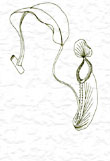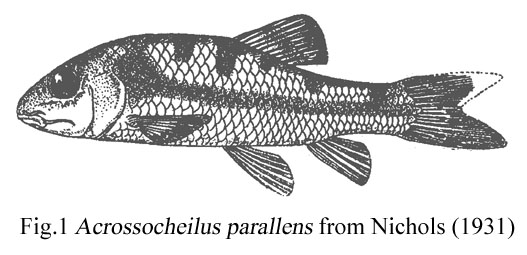

 |
 |
Vertebrates
Acrossocheilus parallens (Nichols) (Osteichthyes: Cyprinidae) newly recorded from Hong Kong
by Keith D.P. Wilson, AFCD
Introduction
The area of eroded hills, west of Castle Peak, bounded by Pak Nai, Black Point, Pillar point and Tuen Mun, holds little obvious interest for ecologists. Largely contained in a designated firing range, the hills have lost most of their forest cover and large areas of hillside have become excessively eroded with complete loss of surface vegetation. Carnivorous plants such as the Pitcher plant, Nepenthes mirabilis and sundew, Drosera sp. flourish in the nutrient deficient moist stream valleys.
During a dragonfly survey of the main stream about 2 km upstream of Pak Nai, where the main stream discharges to the sea at Deep Bay, a population of an unrecorded Acrossocheilus was observed by the author and G.T. Reels. The fish occupied stream pools, with boulders and bedrock as the dominant substrate. The maximum size observed was approximately 10 cm. A specimen was collected for identification. Its identity has proved somewhat problematical and is discussed below.
ACROSSOCHEILUS PARALLENS (NICHOLS, 1931)
Barbus (Lissochilichthys) parallens: Nichols, 1931: 455 - 459, fig. 1, "Description of type. – No. P-92, Lingnan University, from Lung T’au Shaan, Kwangtung, collected in 1926 by Tsang Wai Tak".
Acrossocheilus parallens: Chen et al., 1991: 145 – 146, fig. 78, (Guangdong: north River, east river and west river); Yue Peiqi et al., 2000: 98 – 100, fig. 64, (Guangdong).
Material: 1 specimen, Tai Lang Shui, near Castle Peak, Hong Kong, 19-V-2001, coll. K.D.P. Wilson & G.T. Reels.
Description: Fork length 84 mm. A moderately small cyprinid with two pairs of barbels, six short blackish vertical stripes above the lateral line, a further short blackish vertical stripe above the gill cover, prominent, thick, dark lateral stripe and pale yellow pectoral, ventral, anal and caudal fins. The colour of the sides becomes abruptly pale whitish, below the lateral line. The last dorsal spine is slender and soft and not much thicker than the branched dorsal rays. The specimen collected from Tai Lang Shui differs from typical parallens as there are no fine serrations along the posterior border of the last dorsal spine.
Distribution: Zhujiang River (Guangdong).
Differential diagnosis: A. parallens is separated from its closest congener A. labiatus (Regan), known from Hainan, Fujian and Taiwan, by the lack of black stripes on the dorsal fin membrane, and the presence of fine serrations along the posterior border of the last dorsal spine. In addition A. labiatus lacks a lateral stripe and is not abruptly pale below the lateral line. In the case of the Hong Kong parallens specimen there are no fine serrations along the posterior border of the last dorsal spine but the striped lateral line is very obvious and there are no black stripes on the fin membrane. Other close congeners include A. hemispinus hemispinus (Nichols, 1925), recorded from Mingjiang River (Fujian and Jiangxi), which has a thick last dorsal spine, obviously thicker than soft branched rays, with strong serrations along the posterior border and no vertical bars on sides of body. A. hemispinus cinctus (Lin, 1931), known from Xijiang River (Guangxi and west Guangdong), has, apparently, a slender but ossified last dorsal spine structure, with five or six vertical bars and a horizontal stripe along the lateral line (Lin, 1933). A. wenchowensis Wang also has a thick last dorsal spine, obviously thicker than branched rays, with strong serrations along the posterior border, six vertical bars on sides of body, but lacks the lateral stripe. A. bejiangensis Wu & Lin is very close to A. wenchowensis but five vertical bars on side of the body, and no lateral stripe.
 |
Remarks: Stephen Lai has also observed a species of Acrossocheilus in streams at Ha Fa Shan, northwest of Tsuen Wan, which he considers to belong to this species.
Discussion
The Acrossocheilus genus is a member of the very large subfamily Cyprininae, which has many genera and species in southern and eastern Asia. Acrossocheilus belongs to a group known as the ‘barbs’, which is a heterogeneous assemblage of unrelated genera concentrated in southern China and northern Vietnam, with a few genera, including Acrossocheilus reaching to northern China (Winfield and Nelson, 1991). Fishes belonging to Acrossocheilus are plentiful in southern and eastern China. They are very variable and difficult to define.
A. bejiangensis Wu & Lin is already known from Lantau and recently Bosco Chan has recently reported another species of Acrossocheilus from Kau Lung Hang, near Tai Po, Hong Kong, which is not bejiangensis and he considers may be hemispinus.
The closest congener to parallens is labiatus. Lin (1933) considered Nichols’s (1931) differentiation of parallens from matsudai (a synonym of labiatus) was so unconvincing that he synonymised parallens with labiatus. Indeed it is difficult to separate these two taxa based on structural characters but there are nevertheless distinct catchment and colour marking differences. This synonymy was not accepted by later authors (Chen et al 1991; Yue et al. 2000)
The separation of hemispinus and parallens is also not straightforward. Nichols (1931), who also described hemispinus, makes an interesting point in his original description of parallens. He states that some large specimens of hemispinus may have reduced, or even absent, serrations to the posterior edge of last dorsal spine. Clearly, hemispinus, parallens and labiatus are very closely related species. A. labiatus and hemispinus are known to be sympatric in Fujian but no populations of parallens and hemispinus have been found living together in the same streams, despite the fact they are both found in linked river systems.
It may be that parallens and hemispinus represent a variable species complex with their respective populations linked to distribution. In some cases separation may amount to a qualitative judgment. If parallens is indeed part of a parallens/hemispinus species complex, given that parallens is widespread throughout the Zhujiang River catchment in Guangdong, it would appear improbable that natural populations of hemispinus cinctus, with its known distribution confined to Xijiang River in Guangxi extending to Zhaoqing in Guangdong, could be found in Hong Kong. Hong Kong has much greater affinity to the Zhujiang River catchment than the Xijiang River catchment, which is west of the Pearl Delta. It would appear, based on known geographical distribution, that if natural populations of this complex were to occur in Hong Kong, they are most likely to belong to parallens.
Another scenario is possible. When Lin (1931) established cinctus as a subspecies of hemispinus he may not have been familiar with Nichols’s (1931) description of parallens, from in the same year. Later, Lin (1933) added to the confusion by synonymising parallens with labiatus. Based on the colour markings of cinctus and, more importantly, on Lin’s (1933) description of cinctus material having, "Dorsal with last simple ray ossified, slender and serrated behind" it could be argued that he should have synonymised hemispinus cinctus with parallens, since true hemispinous should have a thick last dorsal spine. This would certainly make more sense based on their type locations and respective catchments. If indeed cinctus is a synonym this also raises the question, which taxon was published first, either hemispinus cinctus or parallens. If hemispinus cinctus was first, then according to the International Rules of Nomenclature, parallens would become a junior synonym of cinctus and Acrossocheilus cinctus (Lin) would become a valid species.
I am not advocating such changes but I strongly recommend that material of Fujian labiatus, Fujian h. hemispinus, Guangxi h. cinctus and Guangdong parallens be carefully compared to resolve the taxonomic confusion between these taxa.
It would appear unlikely, but certainly not impossible, for three naturally occurring species, belonging to the Acrossocheilus genus, to be found in Hong Kong streams. However, it should be noted Southern Chinese Acrossocheilus spp. are occasionally offered for sale in the freshwater aquarium trade in Hong Kong. The possibility that populations of Acrossocheilus have been introduced to Hong Kong streams cannot be discounted.
Bibliography
Chen, X., J-H. Pan, Z. Liu and D. Liang. (1991) In: J-H. Pan, L. Zhong, C-Y. Zheng, H-L. Wu and J-H. Liu (eds.) The Freshwater Fishes of Guangdong Province. Guangdong Science and Technology Press, Guangzhou. 589 p.
Lin, S-Y, (1931). Carp of Kwangtung. 124.
Lin, S-Y. (1933). Contribution to a strudy of Cyprinidae of Kwangtung and adjacent Provinces. Lingnan Sci. J. 12(2): 197-215.
Nichols, J.T. (1925). Some Chinese freshwater fishes, 11. Certain apparently undescribed carps from Fukien. Am. Mus. Novit. 214: 1-3.
Nichols, J.T. (1931). A new Barbus (Lissochilicthys) and a new loach from Kwangtung Province. Lingnan Sci. J. 10(4): 455- 459.
Winfield, I.J., and J.S. Nelson. (1991). Cyprinid Fishes – Systematics, biology and exploitation. Pub. Chapman and Hall.
Yue Peiqi et al. (2000). Fauna Sinica – Osteichthyes – Cyprinformes III. Sci. Press, Beijing, China.
Email: wilsonkd@netvigator.com
P.9-11
|
Porcupine! |
 Copyright © 2000 |